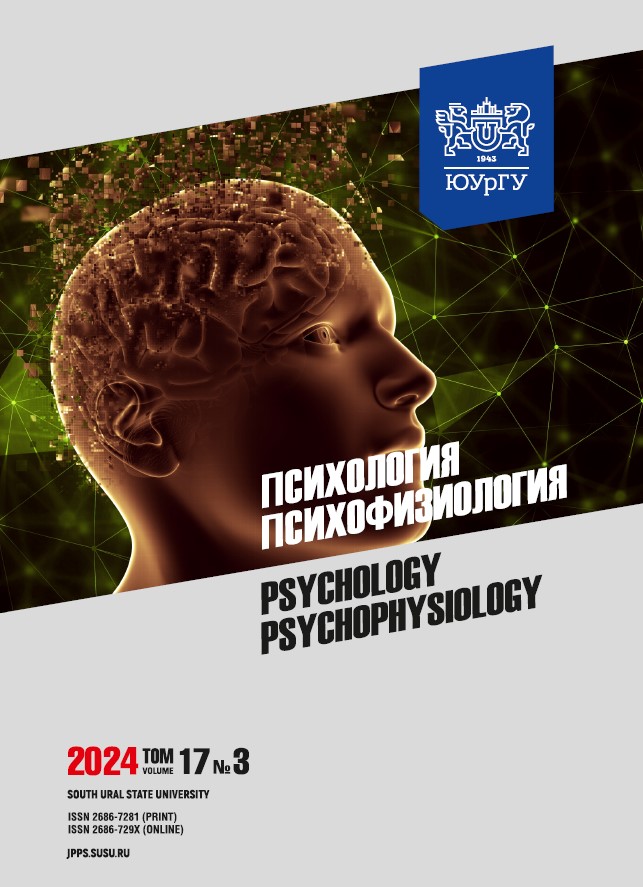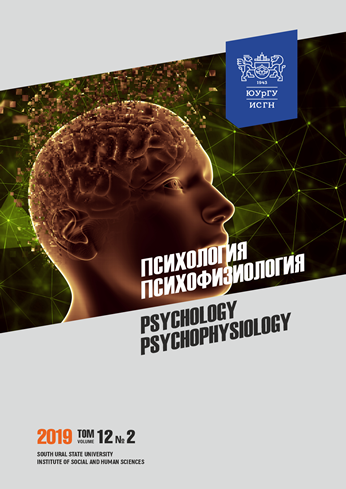Bullying behavior among primary school children: an examination of the underlying risks within contemporary educational settings
Abstract
Introduction. The relevance of the study of potential antecedents leading to the emergence of destructive behaviors among students, particularly those related to bullying within primary school settings, cannot be overstated. This urgency stems from the necessity of ensuring children’s rights and freedoms and providing psychological safety in educational settings. Aims: the objective of this study is to identify the nuances of bullying as a form of destructive relationship between primary school children. Materials and methods: a diagnostic approach was employed with the participation of 18 primary classrooms in Yaroslavl and the Yaroslavl region. The sample comprised over 400 participants, primarily from grades 3 and 4. The main diagnostic tool was the methodology developed by E.G. Norkina, designed to ascertain the bullying structure and the presence of peer-to-peer or teacher aggression, along with identifying the roles of individuals within bullying scenarios. Data analysis took into consideration factors such as sex and academic performance, correlated against classroom teachers’ assessments. Results. Findings indicate that the first manifestations of aggressive and bullying behaviors trace to primary school settings. Primary school students exhibit all the roles characteristic of a bullying system and demonstrate certain bullying strategies. Furthermore, bullying strategies depend on the child's sex and academic performance. Conclusion. The presence of potential antecedents leading to the emergence of destructive behaviors can jeopardize primary school environments. Classroom settings at the end of primary education contain all the elements of the bullying structure with respect to classical understandings of bullying dynamics. The results of the study open up prospects for corrective and developmental initiatives aimed at enhancing the psychological safety of educational settings through the implementation of preventive in-class measures.
Downloads
References
2. Afanasenkova E.L., Vasyagina N.N., Vlasova L.E. et al. Profilaktika deviantnogo povedeniya obuchayushchikhsya v usloviyakh obrazovatelnoi organizatsii [Prevention of deviant behavior of students in an educational organization]. In order N.N. Vasyagina, E.A. Casaeva. Yekaterinburg. 2018:261. (in Russ.).
3. Sovremennye podrostki v epokhu globalnykh peremen: ot delinkventnosti k psikhologicheskoi bezopasnosti [Modern teenagers in the era of global change: from delinquency to psychological security: a collective monograph] / Ed. T.V. Bugaichuk, V.V. Belkina. Yaroslavl. RIO YaGPU. 2022:83 (in Russ.).
4. Filipenko E.V. Prevention of deviant behavior of adolescents in the context of spiritual and moral education. Rossiiskii deviantologicheskii zhurnal = Russian journal of deviant behavior. 2022;3:308-316. DOI: 10.35750/2713-0622-2022-3-308-316 (in Russ.).
5. Krivtsova S.V. Bulling v shkole VS splochennost neravnodushnykh: organizatsionnaya kultura OU dlya resheniya problem distsipliny i protivostoyaniya nasiliyu [Bullying at school WE are the cohesion of the indifferent: the organizational culture of an educational institution to solve problems of discipline and resistance to violence]. Moscow. Federal Institute for the Development of Education. 2011:119 (in Russ.).
6. Holt T.J., Fitzgerald S., Bossler A.M., Chee G., Ng E. Assessing the Risk Factors of Cyber and Mobile Phone Bullying Victimization in a Nationally Representative Sample of Singapore Youth. International Journal of Offender Therapy and Comparative Criminology. 2016;60(5):598–615. DOI: 10.1177/0306624X14554852
7. Ttofi M.M., Farrington D.P., Lösel F., Loeber R. The Predictive Efficiency of School Bullying versus Later Offending: A Systematic / Meta-analytic Review of Longitudinal Studies // Criminal Behaviour and Mental Health. 2011;21(2):80–89. DOI: 10.1002/cbm.808.
8. Berdyshev I.S., Nechaeva M.G. Mediko-psikhologicheskie posledstviya zhestokogo obrashcheniya v detskoi srede. Voprosy diagnostiki i profilaktiki [The medical and psychological consequences of child abuse. Issues of diagnosis and prevention]. St. Petersburg. Rech. 2015:117. (in Russ.).
9. Hawker D.S.J., Boulton M.J. Twenty Years Research on Peer Victimization and Psychosocial Maladjustment: A Meta-Analytic Review of Cross-Sectional Studies. Journal of Child Psychology and Psychiatry and Allied Disciplines. 2000;41(4): 441–455. DOI: 10.1111/1469-7610.00629.
10. Novikova M.A., Rean A.A., Konovalov I.A. Measuring bullying in Russian schools: prevalence, age and gender correlates, and associations with school climate. Voprosy obrazovaniya = Educational Studies Moscow. 2021;3:62–90. (in Russ.). DOI: 10.17323/1814-9545-2021-3-62-90
11. Ivanyushina V.A., Hodorenko D.K., Aleksandrov D.A. Age and gender differences and the contribution of school size and type in the prevalence of bullying. Voprosy obrazovaniya = Educational Studies Moscow. 2021;4:220–242. (in Russ.). DOI: 10.17323/1814-9545-2021-4-220-242
12. Besag V. Bullies and Victims in Schools. A Guide to Understanding and Management. Milton Keynes. Open University Press. 1989:218.
13. Olweus D. Bullying at school: what we know and what we can do. New York. Blackwell. 1993:140.
14. Vtorushina Yu.S., Mitruhina S.V., Vlasova E.N., Antonov V.P. Bullying as a special type of conflict in children and adolescent environment. Vestnik Hakasskogo gosudarstvennogo universiteta im. N.F. Katanova = Bulletin of the N.F. Katanov Khakass State University. 2022;4(42):90–99. (in Russ.).
15. Moos R. Evaluating educational environments: procedures, measures, findings and policy implications. San Francisco. Jossey-Bass. 1979.
16. Baeva I.A. Psihologicheskaya bezopasnost v obrazovanii [Psychological safety in education]. Saint-Petersburg. Soyuz Publ. 2002:270. (in Russ.).
17. Baeva I.A. General psychological categories in practice of research of psychological safety of the educational environment. Izvestiya Rossiiskogo gosudarstvennogo pedagogicheskogo universiteta im. A.I. Gertsena = Izvestia: Herzen University Journal of Humanities and Sciences. 2010;128:27–39. (in Russ.).
18. Bogomyagkova O.N. Psychological security of the individual in the context of inclusive education Yaroslavskii pedagogicheskii vestnik = Yaroslavl Pedagogical Bulletin. 2013;2(4):245–250. (in Russ.).
19. Yasvin V.A. Shkolnaya sreda kak predmet izmereniya: ekspertiza, proektirovanie, upravlenie [School environment as a subject of measurement: expertise, design, management]. Moscow. Public Education. 2019:448. (in Russ.).
20. Кashirsky D.V., Bezuglyak O.S. The development of values-ideals at the transitional stage from preschool to primary school age. Polzunovskii vestnik = Polzunovsky vestnik. 2006;3:116–124. (in Russ.).
21. Belyaeva O.A. Bullying strategies of primary school children: the specifics of formation and manifestation. Cifra. Psihologiya = Cifra. Psychology. 2024;1(2). (in Russ.). DOI: 10.18454/PSY.2024.2.1
22. Kolominsky Ya.L., Psihologiya vzaimootnosheniĭ v malyh gruppah (obshchie i vozrastnye osobennosti) [Psychology of relationships in small groups (general and age-related features)]. Minsk. Tetra Sistems Publ. 2017:432.
23. Bochaver A.A. Hlomov K. D. Bullying as an object of research and a cultural phenomenon. Psikhologiya. Zhurnal Vysshei shkoly ekonomiki = Psychology. Journal of the Higher School of Economics. 2013;10(3):149–159. (in Russ.).
24. Zych I., Farrington D.P., Llorent V.J., Ttofi M.M. Protecting children against bullying and its consequences. New York. Springer. 2017:92. DOI: 10.1007/978-3-319-53028-4
25. Knizhnikova S.V. Prevention of deviant behavior in a general education school: challenges and mistakes. Rossiiskii deviantologicheskii zhurnal = Russian journal of deviant behavior. 2023;1:75–90. (in Russ.). DOI: 10.35750/2713-0622-2023-1-75-90
26. Azerli D.A., Petrova I.E. School violence: a glance from modern russian researchers. Vestnik Nizhegorodskogo universiteta im. N.I. Lobachevskogo. Seriya: Socialnye nauki = Vestnik of Lobachevsky State University of Nizhni Novgorod. Series: Social Sciences. 2013;4(32):7–13 (in Russ.).
27. Glazman O.L. Psychological features of participants of bullying. Izvestiya Rossiiskogo gosudarstvennogo pedagogicheskogo universiteta im. A.I. Gertsena = Izvestia: Herzen University Journal of Humanities and Sciences. 2009;105:159–165. (in Russ.).
28. Olweus D. Bullying at School: Basic Facts and Effects of a School Based Intervention Program. Journal of Child Psychology and Psychiatry. 1994;35(7):1171–1190. DOI: 10.1111/j.1469-7610.1994.tb01229.x.
References on translit
-Copyright (c) 2024 Psychology. Psychophysiology

This work is licensed under a Creative Commons Attribution-NonCommercial-NoDerivatives 4.0 International License.



